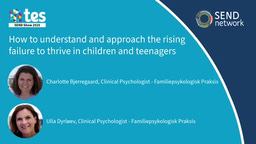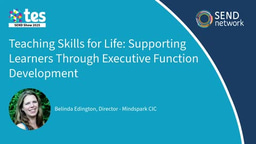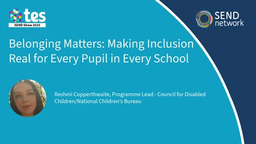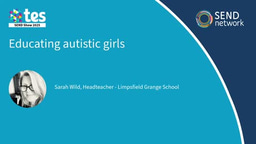Removing barriers to SEND provision

With a drive towards the importance of early identification of special educational needs and disability (SEND) in the early years, the role of the Special Educational Needs Co-ordinator (SENCO) has never been more important than it is in childcare settings today.
Last year in this magazine I wrote a very personal piece about my son which discussed how much of a challenge it has been for our family to find the right place for our son to learn after a long battle to access support. He has since gained a specialist placement in a school that could not be more perfect and he is suddenly thriving and happy to be alive again. However, we could have avoided some of the problems we encountered had his needs been identified and action taken earlier.
There are many places practitioners can look to for support, but different websites and forums give conflicting advice and it can be a challenge to know what best to do in certain situations. This is where it is important to have a practitioner in the role of SENCO, who has undertaken specific training in the identification, assessment and support of young children with SEND.
The latter part of this article will outline the new Level 3 Early Years SENCO qualification provided by Nasen and Cache. However, in today's financial climate of underfunding in all education sectors, it can be difficult to access the support needed for young children with SEND, even with a trained SENCO. There are a number of challenges the sector faces and I hope that by the time you have read this article, you will be able to come away with some practical ideas to take forward within your settings.

Elizabeth Thomas
Using the bioecological model as a lens for SEND
Our poster this month focuses partly on the work of Urie Bronfenbrenner (1917-2005) and his theory of how all aspects of children's lives are interrelated, within a bioecological model (Bronfenbrenner and Evans, 2000). When viewing the children in our settings and attempting to make the right decisions about who needs a little support, who needs a referral and whether or not certain behaviours are a concern, it can be helpful to use this bioecological model as a lens to look through.
This takes into account all of the interactions a child has with the world around them and can sometimes help us to understand that what might have otherwise been seen as a concern, is actually a reaction to something that has happened at home, or a child is adjusting to something new. For example, if a child is struggling to communicate with their peers, it might be helpful to know that they have three older siblings at home and barely have the opportunity to speak there. It may just take a little longer for their spoken language to develop but it would not necessarily need a referral to speech and language therapy.
Another way of using the bioecological model as a lens for SEND is by viewing our role as practitioners and how we need to be a part of the interactions a child has with the people around them, including our relationships with their families. While each level of influence in a child's life has an impact on them, either directly or indirectly, there are also relationships between each level and it can help if practitioners are aware of the influence they can have, not only on the child but within the organisational, community and public policy levels. Figure 1 shows the different levels of influence and a summary of what these might include, as viewed through a bioecological model lens.

Figure 1. Bronfenbrenner's bioecological model related to Special Educational Needs and Disability
Using this model, there are a variety of ways in which practitioners can have a positive influence on a child's experience. The most obvious and direct influence would be the daily interactions with the child themselves, but when their needs become identified as unmet, interactions on other levels need to occur. This would start with the child's family.
‘While campaigning and lobbying the Government is important, it does not produce immediate results and is more of an underlying, purposeful interaction to support children of the future’
Parent knowledge
Parents are the experts in their own children! They know and understand the complexities of a child's background and can give staff vital information which can really help with supporting their child effectively. One easy way of doing this is to ask parents to fill in an ‘all about me’ information form before the child starts at the setting. In this way, practitioners already have the information required to support children effectively from the beginning. If they have always struggled with some separation anxiety and you know this prior to their start date, you can plan their transition to be more flexible. If they are four years old and still wearing nappies, you can support families with this more effectively if you are aware of the reasons why – i.e. they may have a bowel condition or incontinence. Communicating with families on an ongoing basis is vitally important to ensure that the needs of all the children in your care are being met, and particularly if they have identified SEND. It is also very important to take parental concerns seriously and conduct your own investigations into any issues they might have. For example, if their child seems generally happy at your setting but goes home and displays challenging behaviour, this may be because they are tired but it could also be due to unmet needs within the setting. These issues need to be dealt with by trusting parental intuition rather than side-lining their opinion.
Staff supervisions
Supervisions are an ideal time to discuss all of the children attending the setting with their key person. During a supervision session, conversations can be informal and even the slightest concern can be flagged up and noted – it does not matter how small an issue may seem. Documentation of these conversations can be particularly helpful further down the line when seeking support for children, as a good evidence base can be required for parents seeking a diagnosis for their child. With an effective key person strategy within the setting, staff should have good knowledge of their key children and be able to discuss their personalities, what motivates them, how they learn and what their interests are. This is all part of the provision for every child and is a key element of identifying when a child might have SEND, or indeed supporting children more effectively who already have identified additional needs.
Two year check
The two year check was designed as a way of identifying concerns at an early stage to enable the provision of early intervention. It is meant to be carried out when the child is between two-to-three years of age and is a collaboration between early years settings and health visitors. Health visitors look at issues such as sleep, behaviour, eating and growth, whereas childcare practitioners are expected to document and report on learning within the prime areas of the Early Years Foundation Stage. These are Personal, Social and Emotional development, Communication and Language and Physical Development. These areas are considered to be the most important for children at this age because they underpin all other areas of learning.
Ideally, childcare practitioners should be discussing the child alongside a health visitor with the family present, but in practice this does not often occur. One way to ensure a collaboration is to find out from families when their health visitor appointment is going to be and to write a report on the child's development to coincide with the appointment. The family can then give the setting information to the health visitors who will include this in their report. This can be a good way to identify consistent concerns, as the information has come from two different places. If the reports show a concern in the same area, there is more likelihood of an issue being followed up.
Children accessing outside services
Families can gain support from organisational services such as their GP, and practitioners can have an influence on this by writing a letter to the child's GP, backing up any concern the family might have about them. For example, if a child is struggling with self-regulation, social interaction and behaviour both within their childcare setting and at home, a referral to the local child development centre can be requested through the child's GP. Equally, local authority SEN teams have a variety of options for settings to make referrals, such as a social communication team or speech and language therapy service. Setting managers should be aware of who they need to contact in the event of making a referral.
In some cases, after a referral, outside services will work with the child within the childcare setting by making an appointment and talking through the strategies they are using with the setting SENCO. If this is not the case and families are taking their child to the service, setting staff can request to sit in on a session and learn strategies to continue supporting the child within the setting. It can also be helpful for the outside services to gain another perspective on the child as this may influence the service they are providing.
Lobbying the Government
Although this might seem like quite a big step up and perhaps not a level practitioners would believe they have an influence on, lobbying the Government is a really important part of being an effective practitioner and doing everything possible to improve outcomes for children. This can include issues and hot topics such as, historically, the lack of funding in early years and SEND, reviews of the Early Years Foundation Stage and Early Learning Goals, proposed changes to childcare ratios – the list goes on. The Government has ideas for change and makes proposals which result in a public consultation. Practitioners, or indeed any member of the public, are able to read the consultation document and respond to it with their concerns or suggestions about the proposal. Sometimes if practitioners have been particularly vocal about a subject, they are invited to join a focus group to discuss the issues and seek out a way forward that will provide better outcomes for children. Some practitioners choose to do this by using social media like facebook, twitter or a personal blog to share their views on certain subjects and raise awareness of changes that may be occurring within the early years sector.

It is vital that all PVI settings have a trained SENCO
While campaigning and lobbying the Government is important, it does not produce immediate results for young children and is more of an underlying, purposeful interaction to support the children of the future. The amount of time it takes for changes to be implemented can make this task seem almost impossible, but the more practitioners who get involved and speak up for children, the more likely changes will be made.
Outside professional services will often work with children inside the setting
Free training available
While all of these ways of overcoming barriers are practical and helpful, it is also important that theoretical knowledge is applied to situations where practitioners are having to make decisions which will directly impact on a child's future. Nasen has a variety of free resources to support the knowledge and skills of all practitioners working with young children. These are available online to anyone who wishes to access them and it is important that all practitioners recognise the responsibility they have to gain some knowledge and skills in SEND to better support the children in their care. Nasen offers webcasts covering all aspects of SEND in the early years and beyond and a set of four miniguides, each aimed at a different part of the sector and all covering the same essential information. Focus on SEND training is a free structured course of approximately nine hours of learning including online content and practical exercises to engage in. There are also face-to-face training materials, comprising a whole suite of materials which are primarily aimed at early years leaders and managers to use in direct delivery with their staff. However, they are available to everyone.
These free training resources are a good and important start to upskilling childcare practitioners in their SEND knowledge. However, having a fully trained and qualified SENCO within the setting can have a positive impact on children's outcomes, as discovered in the evaluation of the new Level 3 qualification.
New Early Years SENCO Level 3 qualification
While all early years qualifications contain an element of training in SEND, due to the broad spectrum of needs a practitioner may come across in their role, it is unlikely that a small module within a larger qualification would be able to cover the vast amount of material required to fully equip a practitioner for assuming the SENCO role. It is, of course, important to have knowledge of the foundations of SEND in practice; a solid understanding of child development and experience of supporting young children at different ages and stages of development is essential. The new Level 3 qualification developed by Nasen in collaboration with a variety of other agencies contains all of the information required to help develop the skills of the practitioner and enable them to carry out the role of SENCO effectively in their setting. The following information lays out the background to the qualification and explores the impact it has had through implementing the pilot.
Brief background to the qualification and what it involves
The Early Years SENCO qualification (Level 3) is an accredited training programme for SENCOs in private, voluntary and independent (PVI) childcare settings. It was designed in collaboration with educators, training organisations, SEND professionals, setting SENCOs, practitioners and managers from the PVI sector, therefore the content is relevant and realistic. The course comprises an intensive 12.5 day programme with fortnightly delivery and direct learner support and is quality assured by School Improvement Liverpool, Nasen, Jarvis and Cache. It is currently offered in more than 30 local authorities and is still expanding due to Department for Education (DfE) funding, where training is cascaded across more than 20 local authorities and 543 existing SENCOs.
The Level 3 course content offers practitioners both theoretical knowledge and practical support. It develops the skills, knowledge and understanding of SENCO practitioners to ensure that they are capable and confident to effectively support the children and families they work with. There is an option for progression to a higher level diploma on completion.
Outline of the DfE funded pilot and early indicators of impact
The initial roll-out of the pilot training has been funded by the Department for Education. The evaluation of the pilot has been funded by the National Children's Bureau and led by Professor Michael Jopling of the University of Wolverhampton.
The Early Years SEND Level 3 qualification has now been awarded to more than 500 SENCOs and 23 local authorities have upskilled their trainers to deliver it. Nasen has so far received more than 2,200 expressions of interest in participating in the project and there has been a growing demand for progression to Level 4. Due to the positive impact within the areas the qualification has been trialled, these areas have commissioned further training and have committed to funding.
The qualification has been shown to increase the knowledge and confidence of both the facilitators and students with regard to SEND processes and provision. According to Nasen it has empowered practitioners to see themselves as part of the bigger picture of the setting and has raised standards across the sector, leading to better outcomes for children with SEND. Facilitators of the training have reported that other learning points include enabling practitioners to become an agent for change and seeing the importance of having highly qualified and skilled SENCOs in childcare settings.
The broader impact of the qualification has been the development of advice for parents and carers about how settings identify children with SEND. This advice has been helpful in enabling an increase in parent participation and access to local SEND services so that SENCOs can engage in co-production of support rather than trying to support children by themselves.

Practitioner skill and enthusiasm is a setting's most important resource
Feedback suggests the new qualification developed by Nasen and other agencies has shown to provide empowerment, knowledge and skills to SENCO practitioners to engage in their role effectively. Nasen also provides free training resources which are available for any practitioner to access at any time and provide the underpinning knowledge and skills to support practitioners in the identification, assessment of and provision for children in their care with SEND.

The Early Years Level 3 SENCO qualification is already raising standards for SEND provision
While training is an essential tool for knowledge and skills, it can also be helpful to view the child through a bioecological model lens and recognise the influences on children's lives in the different levels of interactions they have with the world. This includes how practitioners can interact with and encourage families, engage in effective supervision sessions with staff to identify the factors influencing their key children's lives, influence local organisational services such as providing information for the child's two year check, writing to the child's GP or providing a referral to speech and language therapy or even responding to government consultations about proposals for changes to early years and SEND provision.
Although having a qualified SENCO within each childcare setting is important for improving children's outcomes, it is also important to recognise that it is the responsibility of all practitioners to engage in some level of learning about SEND and therefore being able to provide the best possible care for young children. Early identification of SEND enables support structures to be put in place in a timely manner to improve provision for these children and give them a positive experience of early years care and education.
Key points
- Having a highly trained and qualified SENCO practitioner within a setting helps to improve outcomes for children
- It's important to remember that parents are the experts on their children. Their views should never be sidelined
- Supervisions provide an ideal opportunity to discuss all children in the setting
- An effective key person strategy will ensure all staff know their children well
- Collaboration with a health visitor is important for the two year check
- In some cases it can be helpful for an outside service to work with the child inside the setting
- Lobbying government for change may not yield quick results but it is an important part of the big picture
- The new Early Years SENCO Level 3 qualification is an important step in the right direction
Useful resources
-
Access free training from Nasen at sendgateway.org.uk
By Elizabeth Thomas, early years teacher, researcher and writer





Please sign in or register for FREE
If you are a registered user on SEND Network, please sign in